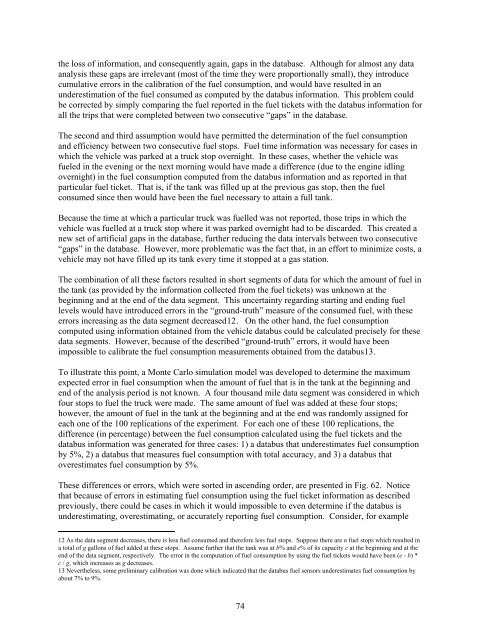Class-8 Heavy Truck Duty Cycle Project Final Report - Center for ...
Class-8 Heavy Truck Duty Cycle Project Final Report - Center for ...
Class-8 Heavy Truck Duty Cycle Project Final Report - Center for ...
Create successful ePaper yourself
Turn your PDF publications into a flip-book with our unique Google optimized e-Paper software.
the loss of in<strong>for</strong>mation, and consequently again, gaps in the database. Although <strong>for</strong> almost any data<br />
analysis these gaps are irrelevant (most of the time they were proportionally small), they introduce<br />
cumulative errors in the calibration of the fuel consumption, and would have resulted in an<br />
underestimation of the fuel consumed as computed by the databus in<strong>for</strong>mation. This problem could<br />
be corrected by simply comparing the fuel reported in the fuel tickets with the databus in<strong>for</strong>mation <strong>for</strong><br />
all the trips that were completed between two consecutive “gaps” in the database.<br />
The second and third assumption would have permitted the determination of the fuel consumption<br />
and efficiency between two consecutive fuel stops. Fuel time in<strong>for</strong>mation was necessary <strong>for</strong> cases in<br />
which the vehicle was parked at a truck stop overnight. In these cases, whether the vehicle was<br />
fueled in the evening or the next morning would have made a difference (due to the engine idling<br />
overnight) in the fuel consumption computed from the databus in<strong>for</strong>mation and as reported in that<br />
particular fuel ticket. That is, if the tank was filled up at the previous gas stop, then the fuel<br />
consumed since then would have been the fuel necessary to attain a full tank.<br />
Because the time at which a particular truck was fuelled was not reported, those trips in which the<br />
vehicle was fuelled at a truck stop where it was parked overnight had to be discarded. This created a<br />
new set of artificial gaps in the database, further reducing the data intervals between two consecutive<br />
“gaps” in the database. However, more problematic was the fact that, in an ef<strong>for</strong>t to minimize costs, a<br />
vehicle may not have filled up its tank every time it stopped at a gas station.<br />
The combination of all these factors resulted in short segments of data <strong>for</strong> which the amount of fuel in<br />
the tank (as provided by the in<strong>for</strong>mation collected from the fuel tickets) was unknown at the<br />
beginning and at the end of the data segment. This uncertainty regarding starting and ending fuel<br />
levels would have introduced errors in the “ground-truth” measure of the consumed fuel, with these<br />
errors increasing as the data segment decreased12. On the other hand, the fuel consumption<br />
computed using in<strong>for</strong>mation obtained from the vehicle databus could be calculated precisely <strong>for</strong> these<br />
data segments. However, because of the described “ground-truth” errors, it would have been<br />
impossible to calibrate the fuel consumption measurements obtained from the databus13.<br />
To illustrate this point, a Monte Carlo simulation model was developed to determine the maximum<br />
expected error in fuel consumption when the amount of fuel that is in the tank at the beginning and<br />
end of the analysis period is not known. A four thousand mile data segment was considered in which<br />
four stops to fuel the truck were made. The same amount of fuel was added at these four stops;<br />
however, the amount of fuel in the tank at the beginning and at the end was randomly assigned <strong>for</strong><br />
each one of the 100 replications of the experiment. For each one of these 100 replications, the<br />
difference (in percentage) between the fuel consumption calculated using the fuel tickets and the<br />
databus in<strong>for</strong>mation was generated <strong>for</strong> three cases: 1) a databus that underestimates fuel consumption<br />
by 5%, 2) a databus that measures fuel consumption with total accuracy, and 3) a databus that<br />
overestimates fuel consumption by 5%.<br />
These differences or errors, which were sorted in ascending order, are presented in Fig. 62. Notice<br />
that because of errors in estimating fuel consumption using the fuel ticket in<strong>for</strong>mation as described<br />
previously, there could be cases in which it would impossible to even determine if the databus is<br />
underestimating, overestimating, or accurately reporting fuel consumption. Consider, <strong>for</strong> example<br />
12 As the data segment decreases, there is less fuel consumed and there<strong>for</strong>e less fuel stops. Suppose there are n fuel stops which resulted in<br />
a total of g gallons of fuel added at these stops. Assume further that the tank was at b% and e% of its capacity c at the beginning and at the<br />
end of the data segment, respectively. The error in the computation of fuel consumption by using the fuel tickets would have been (e - b) *<br />
c / g, which increases as g decreases.<br />
13 Nevertheless, some preliminary calibration was done which indicated that the databus fuel sensors underestimates fuel consumption by<br />
about 7% to 9%.<br />
74
















